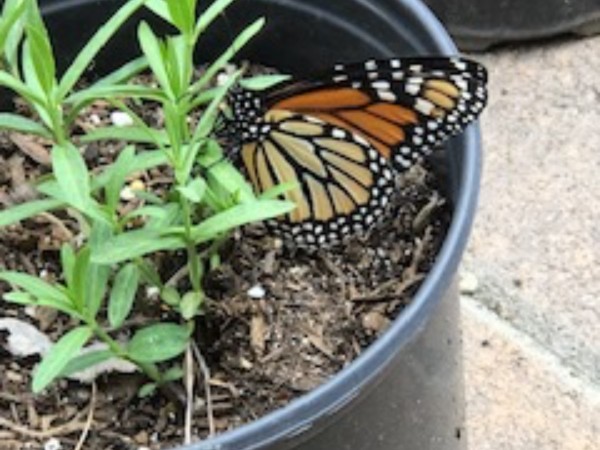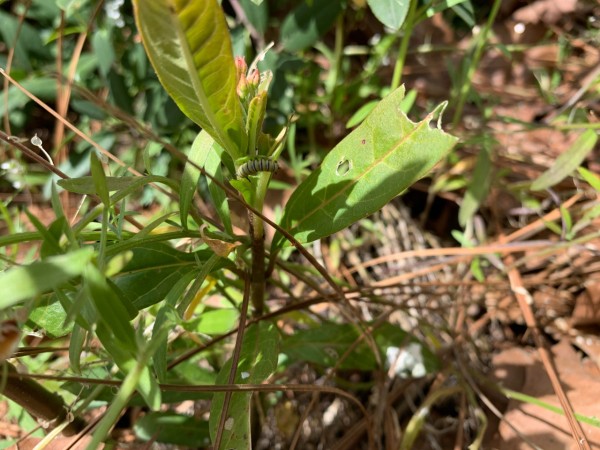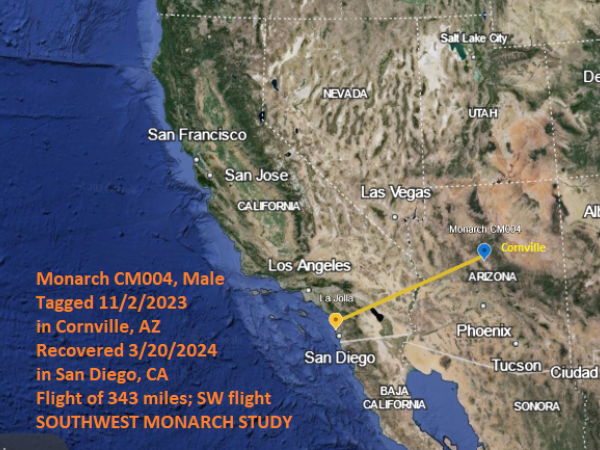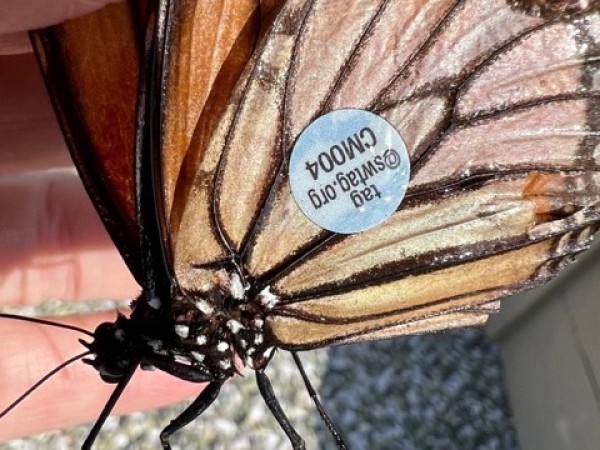Spring Letter #4: Western Monarch Population News From Gail Morris
Early Spring Sightings and Monarch Tag Recovery Spark Questions
Monarchs Mysteries
Monarch and milkweed sightings continue to be small in number this week, a harbinger of the early Spring season. Monarchs are now on their Spring Migration, their long winter life is now ticking away, as they lay eggs where ever they can find milkweed, no matter how small, up and waiting. But an unusual but exciting late sighting of a November tagged monarch raises new questions!
Recent Monarch Sightings
Eager for monarch sightings, Southern California monarch watchers reported several adult monarchs visiting their yards recently in Oxnard, Pasadena, Los Angeles and Glendora. In Orange, Julie found a female laying eggs on a potted native milkweed she had just purchased before she could even get it in the ground!
Joyce spent a few minutes exploring the milkweed patch at Google in Mountain View, California, and looked twice at finding two small monarch larvae! “They were munching away on the tender young tropical milkweed leaves. It was a nice partially sunny afternoon in the upper 60's.”
Monarchs need milkweed up to lay their eggs!
On March 18, Cheryl in Sacramento, California, found it is up and ready. “Asclepias tuberosa (Butterfly weed) making its 2024 debut. This is its 5th season.”
Reports from the Field
Sightings of tagged monarchs are most common during the winter months and peak during the times of the Thanksgiving and New Year Counts at over 300 sites along the coast. Rarely, we hear of a migration sighting of an overwintering tagged monarch.
Last week Wednesday, Jackie noticed a monarch floating in her pool in San Diego, California, near La Jolla! She quickly did a water rescue and went to help the stranded monarch out of her pool. When she finally had him in her hand safely but wet, she noticed he was wearing a blue tag, CM004, and she contacted the email on the tag at the Southwest Monarch Study.
Earlier in the Fall, Denise in Cornville, Arizona, just outside of Cottonwood, sent in her tagging data and noted sadly that there were just not many monarchs to tag this year in Arizona despite searching. Well, it turns out CM004 was one of the very few monarchs Denise managed to tag late in the season in her own backyard on November 2, 2023. A female monarch arrived late in October and laid her eggs on native milkweed. CM004, a male, may have eclosed late in the season but he did still choose to migrate. By late November and early December, monarchs lose the urge to migrate and stay in local regions based on tagging recovery data.
Jackie found CM004 torn and tattered in San Diego, often a sign of a remigrant. So an interesting question arises, "Where did CM004 spend the winter?" Was it in the San Diego area or is he a remigrant flying back up from the Baja coast in Mexico? In years past, monarchs were known to overwinter in good numbers across the Sea of Cortez along the Baja peninsula. The Southwest Monarch Study has one recovery several years ago in Kino Bay, Sonora, along the coast. We may never know the answer, but it’s an amazing late Southwest Monarch Study tagged recovery that raises many questions! A special thank you to Denise for tagging and Jackie for reporting her finding. (See photos)
Send in your reports!
Monarch sightings are usually limited this time of year as they lay eggs to increase their population on their migration to the summer breeding grounds. If you are lucky enough to see a monarch, please report your sighting of any adult, eggs or larvae to Journey North. Your detailed description of what you see can include, but is not limited to, the monarch’s gender and activity. If known, include the type of flowers if they are nectaring or milkweed type if laying eggs. We also encourage you to report milkweed up! Photos encouraged and welcome with all your reports.
Gail
Gail Morris is the Coordinator of the Southwest Monarch Study (www.swmonarchs.org and the Western Monarch Advocates. She is also a Monarch Watch Conservation Specialist, and the Vice President of the Central Arizona Butterfly Association. The Western Monarch Population News is based on comments provided to Gail Morris. We hope to increase the number of sightings and therefore photos and comments entered into Journey North. We rely on the volunteers who communicate regularly with Gail and who agree to participate in our effort to increase awareness of the population of western Monarchs. You can reach her at gail@swmonarchs.org




